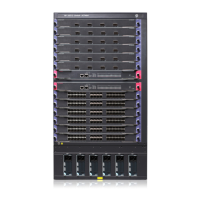261
Ste
Command
Remarks
15. Create an RR reflection policy.
rr-filter
extended-community-list-number
Optional.
By default, an RR does not filter the
reflected routes.
With an RR reflection policy, only
IBGP routes whose Extended
Communities attribute matches the
specified one are reflected.
By configuring different RR
reflection policies on different RRs,
you can implement load balancing
among the RRs.
Configuring specific routing features for BGP-VPNv4 subaddress family
Ste
Command
Remarks
1. Enter system view.
system-view N/A
2. Enter BGP view.
bgp as-number N/A
3. Configure the remote PE as
the peer.
peer ip-address as-number
as-number
N/A
4. Specify the interface for TCP
connection.
peer ip-address connect-interface
interface-type interface-number
N/A
5. Enter BGP-VPNv4 subaddress
family view.
ipv4-family vpnv4 N/A
6. Set the default value of the
local preference.
default local-preference value
Optional.
100 by default.
7. Set the default value for the
system MED.
default med med-value
Optional.
By default, the default value of the
system MED is 0.
8. Filter all or certain types of
routes to be advertised.
filter-policy { acl-number |
ip-prefix ip-prefix-name } export
[ direct | isis process-id | ospf
process-id | rip process-id | static ]
Optional.
By default, BGP does not filter
routes to be advertised.
9. Filter received routes.
filter-policy { acl-number |
ip-prefix ip-prefix-name } import
Optional.
By default, BGP does not filter
received routes.
10. Advertise community
attributes to a peer or peer
group.
peer { group-name | ip-address }
advertise-community
Optional.
By default, no community attributes
are advertised to any peer or peer
group.
11. Filter routes received from or
to be advertised to a peer or
peer group based on an
AS_PATH list.
peer { group-name | ip-address }
as-path-acl aspath-filter-number
{ import | export }
Optional.
By default, no AS filtering list is
applied to a peer or peer group.

